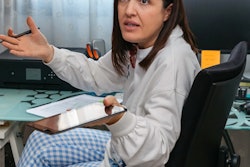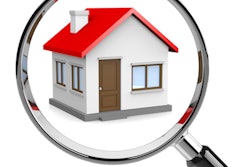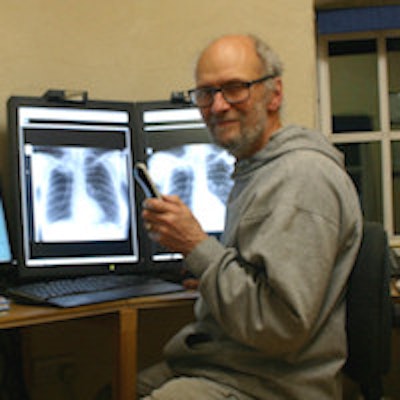
As the medical imaging community across Europe seeks more innovative ways to cope with increasing demand, while avoiding reporting delays and burnout, many people believe home reporting by radiologists has a vital future role to play. Eighteen months after AuntMinnieEurope.com featured his pilot scheme for home-based interpretation, we catch up again with Dr. Richard Harries to find out how he works.
Harries set up his home-based practice in 2011, after he retired from his position as consultant radiologist at the Northern Lincolnshire and Goole National Health Service (NHS) Trust in the U.K. Now in his sixth year as a home-based radiologist, he continues to read between 25,000 and 35,000 scans a year. His NHS contract to provide around 20 hours of home reporting and one day a week as a consultant at Diana, Princess of Wales Hospital in Grimsby -- 32 km from home -- has helped to ease the backlog of reports and improve radiology services for patients, he said.
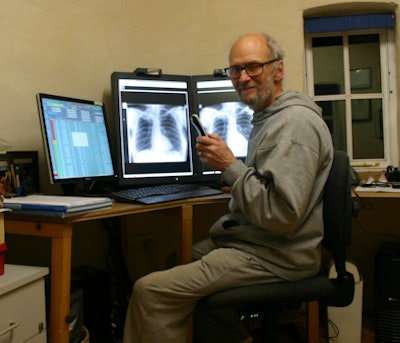 Speed is a top priority for Dr. Richard Harries.
Speed is a top priority for Dr. Richard Harries.Ideally suited to the older radiologist, home reporting offers flexibility for those who wish to work somewhere less than full-time, as well as providing lifelong learning opportunities and the chance to work for other healthcare providers, according to Harries. There are also several reasons why home reporting might be a desirable solution for both radiologist and hospital managers.
"The U.K. has a radiology reporting workforce under considerable pressure with a steadily increasing workload. Working at home is one way in which the Royal College of Radiologists [RCR] is hoping to cope with this discrepancy between demand and availability of specialists," he said.
Getting technical
At the recent Radiology Information Systems and PACS Conference in London organized by Healthcare Conferences U.K. (HC-UK), Harries provided an overview of planning and implementing a home-reporting service.
The ideal setup is fast, responsive, reliable, expandable, and cheap, he explained. Download/upload speeds must be at least as fast as in-department speeds, with the same standards and safeguards such as internet security, peer review, and discrepancy meetings. The system must cope with rapidly changing demands with minimum downtime, and crucially it should be easy to deploy and maintain. Harries' current system is not perfect, but over three years from 2013 to 2016, he delivered 74,757 x-ray reports (24,919/year), with only around 25 hours spent resolving technical issues.
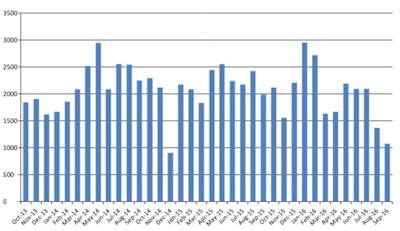 Harries provides a varied month-by-month turnover in his reporting, depending on holidays and other commitments.
Harries provides a varied month-by-month turnover in his reporting, depending on holidays and other commitments.Home workers need to decide what type of monitor to use. Medical grade monitors have better accuracy than commercial off-the-shelf (COTS) monitors, but this comes with a big price difference, he noted. COTS 3k monitors can be bought for a few hundred pounds, but the latest 3k Eizo medical monitors, for instance, cost around 2,655 pounds (3,074 euros). However, these monitors have guaranteed performance with a five-year warranty period that includes onsite next-day replacement. They also have DICOM Grayscale Display Function (GSDF) and embedded sensors for quality assurance, which can be essential for medical diagnosis.
Additionally, most workstation setups with twin 3k monitors will require a graphics card with multiple outputs, although the latest Eizo monitor, the RX350, can daisy chain so that the graphics card only needs a single output, he commented.
At home with Harries: What he's got
- Two 3 MP color monitors (Eizo)
- 1.2 MP monitor for nonimage data
- PC with 3.4 GHz Intel processor, 8 MB Ram, Windows 7
- 256 GB SATA Solid State Drive
- Cisco VPN Client v.5.0
- BT Business Broadband at 38 Mbps
- eFilm 4.0 DICOM viewer
- Soliton RIS
- Access to pathology, etc.
Home workers must decide about how to send and receive images -- whether this is through broadband using a virtual private network (VPN) with a third-party DICOM viewer, or alternatively through installing PACS client on a remote computer and downloading images as and when they are needed, or downloading in batches into a local cache.
Speed is a top priority, Harries noted. With his own setup, VPN speed is mostly stable at 35 Mb/s but occasionally drops to under 10 Mb/s. Speed requirements will depend on how urgent the reporting is, and how much reporting the radiologist intends to do.
In his experience, BT Business broadband at 8Mb/s is adequate for downloading overnight batches but frustratingly slow if the download fails. On the other hand, BT Business broadband at 38Mb/s is almost fast enough for hot reporting. Typically, when downloading batches, 35 Mb/s will allow approximately nine computed radiography (CR)/digital radiography (DR) images or 700 CT images to be downloaded per minute. When downloading individual studies, as opposed to batches, there is a delay of five to 10 seconds before download begins, which is why hot reporting is not really practical at this bandwidth, he added.
Contracts and costs
Employment and financial considerations are key to any decision for hospitals and individuals to implement a home-reporting scheme, particularly in terms of who to employ, and defining contractual minimum workloads: Retired, semiretired, or those on maternity or paternity leave could prove suitable candidates. But for part-time radiologists, keeping up with continuous medical education (CME) can be challenging as there is currently no pro-rata reduction in CME requirements for revalidation, according to Harries.
Furthermore, employing overseas colleagues might be problematic if the equipment is to be installed and maintained by IT staff at the host hospital, and there may be issues related to language and differences in interpretation, he said.
When weighing up in-house reporting versus home reporting, hospitals or other backers will be keen to understand how quickly payback will be possible. Setup costs to consider are workstation and monitors, DICOM viewer license, and voice recognition license, while revenue costs include licences, hardware and software maintenance, broadband and VPN costs, and IT support.
Contractual pay rates could prove beneficial to both parties, according to Harries. An NHS trust, or hospital group, might pay a radiologist less per examination for reporting at home than for extracontractual reporting in the department, the reduction being offset by less traveling time and lower fuel costs for the home reporter. If, like Harries, a home-based radiologist generated around 74,000 reports over three years, this could represent a significant saving that would cover ongoing costs such as license fees and maintenance.
Looking to the future
Harries reports there is still a small issue with the downloading system sporadically not working, but thinks that is related to the PACS rather than the Soliton RIS.
"Staff at Soliton IT are very quick at resolving these issues, even at the weekend, so it doesn't affect me much. It's a minor irritation and over the past year I have spent very little time on those technical issues," he noted.
He hasn't needed to replace any hardware or software, but doesn't yet know if the change in the hospital PACS scheduled for later this year will affect his home setup. Harries still works one day a week in Grimsby Hospital and finds that this, together with the messaging system on Soliton RIS, gives him sufficient contact with colleagues.
Given the rising demand for imaging and ongoing shortage of radiologists in the U.K., Harries thinks home reporting will continue to have a role.
"There was a 26.5% increase in radiology examinations between 2004-05 and 2010-11 -- CT increased by 86% and MRI by 125% in the same period -- and there has also been a 20% reduction in the time available for reporting," he said. "In 2010, in the U.K., there were 4.6 radiologists/100,000 population, whereas other comparable European countries have 8/100,000. Furthermore, of 2,967 U.K. posts in 2010, 245 were vacant."
Editor's Note: A second article about home reporting will follow later in June. Also, further updates about how home reporting can be part of radiology service delivery will be given during the RCR17 meeting, to be held in Liverpool in September.





